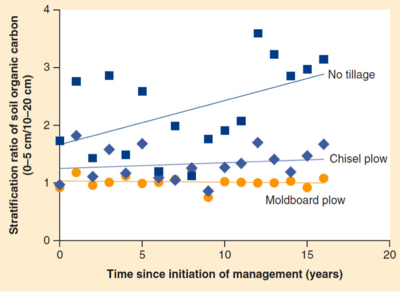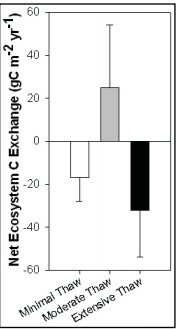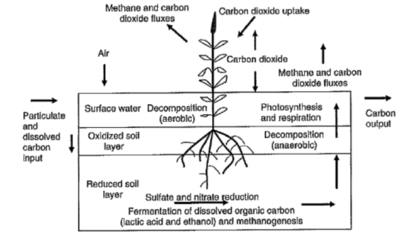Carbon cycle
Introduction
Globally, carbon cycles among the oceans, atmosphere, terrestrial biosphere, ecosystem, and geosphere. This wiki page focuses on carbon dynamics in soil. Soil organic matter (SOM) is the largest terrestrial carbon pool and contains more than three times as much carbon as either the atmospheric or living plant pools[1]. In section 2, the first part of the wiki, we describe how organic residues are broken down in soil, focusing on the role of microbes as decomposers. By emphasizing the role of microbes, we hope to build a better nexus of information between organic input decay and SOM formation. So, in the next section we discuss the importance, formation, and recent research of SOM. Topics covered in sections 2 and 3 are integrated into three SOM formation models in section 3.5. There have been a lot of recent discoveries and many newly developed models surrounding SOM. As such, the predominant views may well be subject to change. After decomposition and SOM, we move toward focusing on real world applications and impacts of the carbon cycle in soil. The carbon cycle has a huge role in maintaining the world’s climate and ecosystems. SOM, being the primary pool of carbon, is of crucial importance in climate change, as demonstrated in section 3. For thousands of years, humans have interacted with soil and the carbon cycle through agriculture. However, only now are we starting to properly understand the impact agricultural practices have on soil. Driven by the strong impetus to better understand carbon dynamics in agroecosystems, we discuss carbon management strategies in agricultural systems in section 4. Permafrost thaw and drainage of wetlands are presented in section 5, as two “case studies” of soil carbon cycle. The carbon cycle, like most natural cycles and models, is not a system closed from outside influences. There are many interlocking elements throughout cycles of nutrients, carbon, and nitrogen in soils. The nitrogen cycle is especially closely linked to the carbon cycle in microbiology because of the importance of C/N ratios. A thorough understanding of the Nitrogen Cycle will greatly improve our understanding of the carbon cycle in turn.
Soil Organic Carbon in Agricultural System
Successful farming requires good, healthy soil. Good agricultural soil means lots of soil carbon and organic matter. The very nature of farming, growing and removing plants from soil again and again, removes a certain amount of carbon and other resources from the soil. However, a lot of the conventional practices around farming serve to damage soil and alter the carbon cycle far more than necessary. Many modern sustainable farming methods have been shown to greatly increase soil health. There are two different ways of approaching the problem, decreasing the amount of carbon lost and increasing the amount of carbon input.
Reducing Carbon Losses
- Carbon being lost from an agricultural system because of crop harvesting is unavoidable. The damage to soil can be reduced by growing less carbon intensive crops. Crops like corn return much of the plant carbon to the soil after a harvest from the husks and stalks of the plant. Another route by which carbon is lost from agricultural systems is via microbial respiration. Conventional farming greatly enhances these losses through tillage.
- Tillage: Tillage is the practice of mixing and aerating soil by breaking it apart and turning it. Tilling practices increase oxygen availability to microbes and expose aggregate bound organic matter to microbes. As a result, high tillage increases microbial activity and soil respiration releasing previously soil bound carbon as carbon dioxide into the atmosphere. Tilling also damages soil structure, increasing erosion and removing yet more valuable organic carbon from fields. The increased attention on sustainable farming practices over the past decades has led to an increase in “no till” farming. In no till and reduced till systems levels of soil organic carbon, microbial biomass, and mineralizable nitrogen are significantly higher. In fact, gains in SOC were 250 kg/ha/yr higher in minimal till than in conventional systems. (33) Soil structure also improves greatly under no till farming. A reduction in tilling from conventional to no or minimal till increases macro aggregation by 21% - 42%. (33) The chart below shows the difference in the stratification ratio, a measure of organic matter at the surface of the soil over organic matter a bit deeper. No till systems have far more surface organic matter which helps fend off erosion and better facilitates seedling growth and root growth (32).
Increasing Carbon Inputs
- Practices for increasing carbon inputs have been used in traditional farming for a long time. Native americans often farmed polycultures, and crop rotations have been in use for hundreds of years. However, in modern conventional farming, where convenience of harvesting has outstripped the benefits of these techniques, there are very few carbon inputs to agricultural systems. While harder to implement in large scale farming these techniques are very important in practicing a sustainable model of agriculture.
- Monocultures, Crop Rotations, Polycultures, and Cover Crops: Monocultures, the system of growing a single crop continuously in the same soil, are common because of the simplicity of dealing with a single crop. However monoculture systems lead to lowered carbon, nitrogen, microbial biomass and diversity, and soil enzyme levels. One alternative to a monoculture is a crop rotation. Crop rotations are when alternating crops are grown in the soil. The benefits of crop rotation depend on what crops are rotated. Crop rotations shown to be especially beneficial to SOC levels include legumes and sweet clover. Both of these are often used as cover crops. Cover crops are, instead of being harvested, either tilled into, or laid on top of the soil. Cover cropping provides an annual boon of plant residue to the soil, massively increasing carbon in soil. Another system, less commonly used is that of a polyculture. A polyculture is a system in which multiple crops are grown at the same time. The diversity of crops allows for more diverse microbial communities and a greater variety of plant residue in the soil.
- Carbon Sequestration: The techniques that increase the amount of carbon in soil, no till with high carbon inputs, not only improve soil longevity in farming but also cause carbon sequestration. Carbon sequestration is the process by which carbon is taken from the atmosphere and stored long term, in this case as soil organic carbon. Switching from a conventional to a no till, organic system can sequester 22 gC/m2/yr. (33) There are movements all over the world to implement conservation farming methods. The sequestration of carbon in soil would not only increase the sustainability of farms, but also help reduce the carbon in the atmosphere, combating the buildup of greenhouse gases in the atmosphere.
- Recent Research: Recent research into conserving soil organic matter in agricultural systems suggests that minimizing tillage and introducing plant residues isn’t what ultimately conserves more organic matter. Microbial biomass is what ultimately creates organic matter. Results drawn by Kallenbach, Grandy, Frey, and Diefendorf (28) indicate that microbial growth rates and carbon use efficiency are associated with more conversion of carbon into microbial biomass and mineralized soil organic carbon. Enhancing the transformation of plant carbon to microbial biomass is a developing, exciting area of research that could lead to more effective agricultural management. Microbes, by breaking down organic molecules and facilitating the mineralization of carbon, are essential in storing carbon in soil for carbon sequestration.
Case Study
Permafrost Thaw
- Permafrost is a subsurface soil layer that remains frozen throughout the year. When the permafrost is thawed or unfrozen, it can either increase greenhouse gas emissions or sequester more carbon in the carbon cycle. According to “Permafrost Thaw and Carbon Balance”, more than 50% of global terrestrial C is already stored in permafrost regions as soil organic matter[29].
- Carbon is naturally photosynthesized/uptaken by plants into the soil ecosystem and respired in the form of CO2 back into atmosphere by plants, animals, and microbes (bacteria). A carbon sink occurs when the uptake of CO2 by plants is greater than the emission of CO2 into the atmosphere by the process of respiration. A carbon source occurs when the emission of CO2 into the atmosphere by respiring microbes and plants is greater than the uptake of CO2 by plants. As reported from “Permafrost Thaw and Carbon Balance”, when the climate gets warmer, permafrost thaw can change the ecosystem carbon balance to a sink or a source [29].
- As stated by United Nations Environment Program, “[Thawing] of the Arctic permafrost is a “wild card” that could dramatically worsen global warming by releasing massive amounts of greenhouse gases…” [29]. How does it do that? Well, the reason global warming is associated with permafrost thaw is because when permafrost is thawed, it can stimulate great amounts of microbial decomposition of soil organic matter. This stimulation of decomposition will decrease the C content stored in soil by releasing more CO2 into the atmosphere. The CO2 that is released into atmosphere contributes to the cycle of greenhouse gases involved in climate change.
- In an experiment conducted by researchers from the University of Florida, C balance was intensively measured during the growing seasons in three separate conditions (minimally thawed permafrost, moderately thawed permafrost, and extensively thawed permafrost). In the corresponding graph, the results of the study recorded accounted for both the growing and non-growing seasons. Researchers found that during non-growing seasons and minimal permafrost conditions, plants do not uptake C from the atmosphere but rather microorganisms release CO2 into the atmosphere indicated by the white bar in the graph. In moderately permafrost thawed, C uptake exceeded C emission because of stimulation in decomposition which signified a carbon sink occurrence. Lastly, extensive permafrost thaw observed a C emission that exceeded C uptake which signified a carbon source occurrence which released large amounts of greenhouse gases to the atmosphere. Based on the measurements, Schuur concluded that “the net release of C to the atmosphere in landscapes where there is advanced permafrost thaw adds to the existing problem of increasing greenhouse gases in the atmosphere. This C release from permafrost thaw may create a dramatic feedback that accelerates climate change”[29]
Drainage of Wetlands
- Drainage of wetlands could either increase or decrease methane production but will most certainly lose massive amounts of organic carbon sequestered in the soil from the carbon cycle. According to “The Role of Wetlands in the Carbon Cycle”, wetlands operate “six to nine percent of the Earth’s surface and contain about 35 percent of global terrestrial carbon”[30]. Wetlands are capable of high productivity meaning that they have a high capacity to sequester and store carbon. Wetlands sequester and store carbon into biomass and organic matter by photosynthesizing CO2 from the atmosphere. Like permafrost thaw, seasons can affect wetlands by turning it into either a carbon sink or carbon source.
- As reported by the Department of Sustainability, Environment, Water, Population and Communities, wetlands are subjected to seasonal “waterlogging” conditions that induce anaerobic conditions[30]. When the wetlands are subjected to inundated/anaerobic conditions, the emission of greenhouse gases (N2O and CH4) and carbon or methane sinks are created. It is because wetlands naturally store significant amounts of carbon, that during drainage conditions, wetlands emit a significant amount of greenhouse gases. However, it is also noted that these drainage of channels also contribute to emission of methane to atmosphere. These “so-called” channels are hydrological connections that exist between watercourses and designated pathways to saturate wetlands with carbon and nutrients. During aerobic conditions, soil levels are oxygenated and methane production is decreased.
Climate Change on Wetland Carbon Cycles
- As predicted by the Department of Sustainability, Environment, Water, Population and Communities, climate can play a part in the methane emission and carbon storage in wetland soils. Natural disturbances such as drainage of wetland soils will oxidize/aerate soils which decreases methane production which lead to large net losses of sediment organic carbon. In addition, depending on the climate change, wetland carbon cycle can altered in the following number of ways:
- Warmer climates will accelerate the rate of CO2 and methane production from wetland soils
- Wetter climates will increase wetland surface areas and promote carbon sequestration and increased primary production, but may increase methane emissions.
- Drier climates will increase the oxidation of carbon stores but reduce methane emissions.
Policies and Programs
- A number of policies and outreach programs have been place to provide a positive feedback towards degradation of wetlands and emission of greenhouse gases by offsetting carbon sequestration and sources.. One of such policy called the Carbon Farming Initiative is currently carried out by the Department of Climate Change and Energy Efficiency. The policy is to implement change within the farmers’ lands. By storing excess greenhouse gas emission from wetlands into their lands, the farmers are able to earn carbon credits. Other organizations such as Regional Natural Resource Management Planning for Climate Change Fund and Biodiversity Fund are implementing policies to maintain healthy levels of greenhouse gas emission in wetlands.
References
- ↑ Fischlin, A. et al.(2007). Climate Change 2007: Impacts, Adaptation and Vulnerability. Cambridge Univ. Press, 211–272.
1.M. Francesca Cotrufo et al. (2013) The Microbial Efficiency-Matrix Stabilization (MEMS) framework integrates plant litter decomposition with soil organic matter stabilization: do labile plant inputs form stable soil organic matter? Global Change Biology,19, 988–995.
2.Sylvia, D.M., Fuhrmann, J.J., Hartel, P.G.,& Zuberer, D.A. (2005).Principles and Applications of Soil Microbiology, Second Edition. Prentice Hall, Upper Saddle River, NJ, 346,359,497-501 and 285-287 pp.
3.Stevenson, F.J., Cole, M.A.. (1999). Cycles of Soils: Carbon, Nitrogen Phosphorus, Sulfur, Micronutrients. New York, NY: John Wiley & Sons, Inc.
4.Fischlin, A. et al.(2007). Climate Change 2007: Impacts, Adaptation and Vulnerability. Cambridge Univ. Press, 211–272.
5.Baldock J (2007).Composition and cycling of organic C in soil. In: Nutrient Cycling in Terrestrial Ecosystems.Springer,pp. 1–35.
6.Kell DB (2011).Breeding crop plants with deep roots: their role in sustainable carbon nutrient and water sequestration. Annals of Botany, 108, 407–418.
7.Sollins, P., Swanston, C. & Kramer, M. (2007).Stabilization and destabilization of soil organic matter—a new focus. Biogeochemistry 85, 1–7.
8.Schmidt MWI, Torn MS, Abiven S et al. (2011) Persistence of soil organic matter as an ecosystem property. Nature, 478, 49–56.
9.Johannels Lehmann, Markus Kleber. (2015). The contentious nature of soil organic matter. Nature, 528, 60–68.
10.Marschner, B. et al. (2008). How relevant is recalcitrance for the stabilization of organic matter in soils? J. Plant Nutr. Soil Sci. 171, 91–110.
11.Amelung, W., Brodowski, S., Sandhage-Hofmann, A. & Bol, R. (2008).Combining biomarker with stable isotope analysis for assessing the transformation and turnover of soil organic matter. Adv. Agron. 100, 155–250.
12.Anja Miltner et al, (2012) SOM genesis: microbial biomass as a significant source. Biogeochemistry,111,41–55.
13.Liang C, Balser TC (2010) Microbial production of recalcitrant organic matter in global soils: implications for productivity and climate policy. Nat Rev Microbiol 9:75.
14.Six J, Frey SD, Thiet RK, Batten KM (2006) Bacterial and fungal contributions to carbon sequestration in agroecosystems. Soil Sci Soc Am J 70:555–569.
15.Lekkerkerk LJA, Lundkvist H, Agren G, Ekbohm G, Bosatta E (1990) Decomposition of heterogeneous substrates: an experimental investigation of a hypothesis on substrate and microbial properties. Soil Biology & Biochemistry, 22, 161–167.
16.Simpson AJ, Simpson MJ, Smith E, Kelleher BP (2007) Microbially derived inputs to soil organic matter: are current estimates too low? Environmental Science & Technology, 41, 8070–8076.
17.Raes, J. & Bork, P.(2008) Molecular eco-systems biology: towards an understanding of community function. Nature Rev. Microbiol. 6, 693–699.
18.Morales, S. E.&Holben,W. E.(2011). Linkingbacterial identitiesandecosystemprocesses:can ’omic’ analyses be more than the sumof their parts? FEMS Microbiol. Ecol. 75, 2–16.
19.Sollins, P., Homann, P., Caldwell, B. A. (1996): Stabilisation and destabilisation of soil organic matter: mechanisms and controls.Geoderma 74, 65–105.
20.Jennifer A. J. Dungait, et al. (2012) Soil organic matter turnover is governed by accessibility not recalcitrance. Global Change Biology, 18, 1781-1796.
21.Margit von Lützow et al.(2008) Stabilization mechanisms of organic matter in four temperate soils:Development and application of a conceptual model. J. Plant Nutr. Soil Sci, 171, 111–124.
22.Davidson, E. A. & Janssens, I. A. (2006).Temperature sensitivity of soil carbon decomposition and feedbacks to climate change. Nature 440, 165–173.
23.Conant, R. T. et al. (2008).Sensitivity of organic matter decomposition to warming varies with its quality. Glob. Change Biol. 14, 868–877.
24.Wickland KP, Neff JC, Aiken GR (2007) Dissolved organic carbon in Alaskan boreal forest: sources, chemical characteristics and biodegradability. Ecosystems, 10,1323–1340, doi: 10.1007/s10021-007-9101-4.
25.Kleber, M., Sollins, P. & Sutton, R.(2007). A conceptual model of organo-mineral interactions in soils: Self-assembly of organic molecular fragments into zonal structures on mineral surfaces. Biogeochemistry 85, 924.
26.M. Francesca Cotrufo, et al. (2015) Formation of soil organic matter via biochemical and physical pathways of litter mass loss. Nature Geoscience 8, 776–779.
27.B. Liang, J. Lehmann, D. Solomon, J. Kinyangi, J. Grossman, B. O’Neill, J. O. Skjemstad, J. Thies, F. J. Luizao, J. Petersen, and E. G. Neves. (2006). Black carbon increases cation exchange capacity in soils. Soil Science Society of America, 70, 1719-1730.
28.C.M. Kallenbach , A.S. Grandy , S.D. Frey , A.F. Diefendorf. (2015). Microbial physiology and necromass regulate agricultural soil carbon. Soil Biology and Biochemistry, 91, 279-290.
29.Schuur, Ted. (2013): 117. "Permafrost Thaw Predictions." Science Experience Your America. Department of Botany, University of Florida, 2009. Web.
30.Foster, .John, Lisa Evans, Alison Curtin, and Brydie Hill. (2012) The Role of Wetlands in the Carbon Cycle. Issues Paper The Role of Wetlands in the Carbon Cycle (2012): n. pag. Department of Environment. Australian Government, 2012. Web.
31.Osman, Khan Towhid. (2013). Soils’: Principle, Properties, and Management. Springer Dordrecht Heidelberg New York London, 93-95.
32.Franzluebbers, A. J. (2013). Pursuing robust agroecosystem functioning through effective soil organic carbon management. Carbon Management, 4(1), 43–56.
33.X. Liu1, S.J. Herbert, A.M. Hashemi, X. Zhang, G. Ding. (2006) Effects of agricultural management on soil organic matter and carbon transformation – a review. Plant Soil Environment, 52(12), 531-543
Recently edited by students of Kate Scow, Winter 2016.



